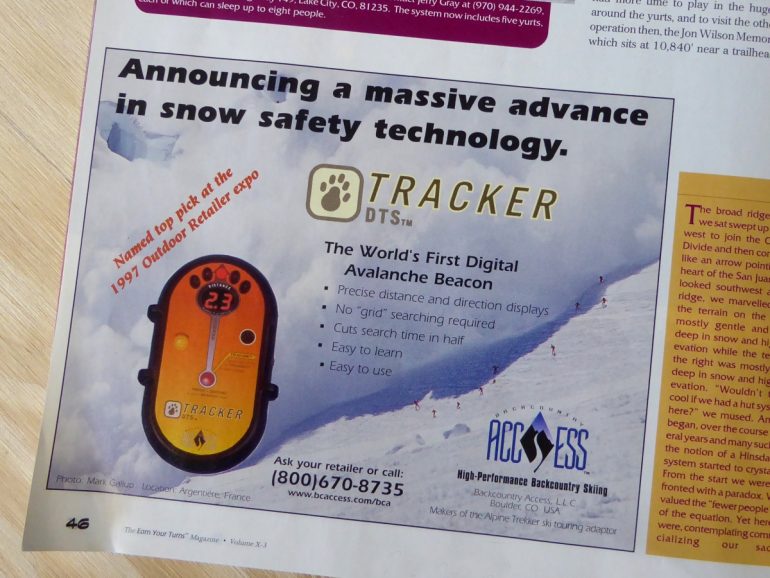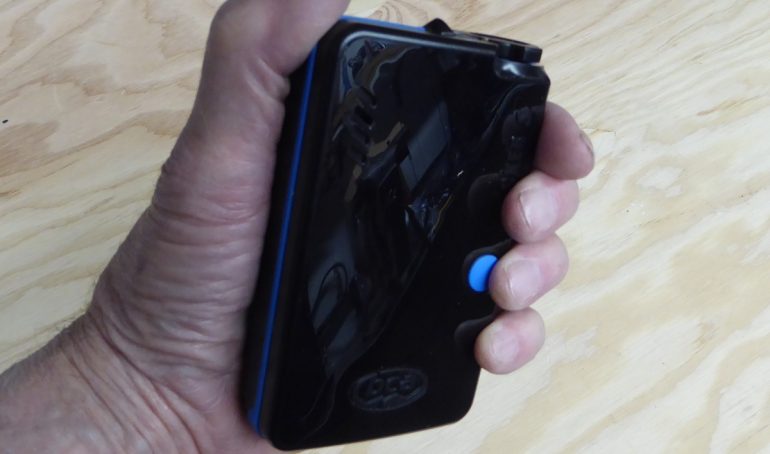
Backcountry Access display advertising from Couloir Magazine, December 1997. An earthquake hit avalanche rescue with the introduction of the first digital, multi-antenna beacon. The first retail model is pictured above. The small yellow button on the left side invokes a “Special Mode” that limits the angle of signal reception, to help with multi-burial searches. This pictured freshman model had no labeling for Special Mode. As BCA tends to do, their snow-shattering announcement was somewhat understated.
Tracing the evolution of BCA’s tranceivers
In winter 1997-98, a sea change hit avalanche safety. Backcountry Access retailed the first digital signal processing multi-antenna avalanche rescue transceiver, the Tracker. There were a few “digital” beacons prior to this, defined as units with a modicum of signal processing. But to the best of my knowledge all had a single antenna and required grid searching for both fine and course search.
I was skeptical at the beginning of the “antenna revolution.” But the point-and-shoot multi-antenna concept soon won me over. Sure, I could grid search an avalanche burial just about as fast as I could search with a Tracker, but how about my friends and loved ones (or guided clients) who might be looking for yours truly? Combined with a smidge of practice, Tracker really was point-and-shoot. Correctly operated, it would walk you to the burial like a faithful service dog navigating you through a crosswalk. During practice drills, I found it to be so accurate I began leaving my probe at home (though I eventually succumbed to cultural pressure and do carry a probe except during ultra-safe outings).
Note: For those of you curious about exact comparison between BCA models, I added the BCA matrix chart to the bottom of this post. Beyond that, the BCA website has always been one of the better “content marketing” efforts out there, with real information not fluff.
Tracker DTS soon boasted an upgraded look, but worked pretty much the same. It labeled the Special Mode button. See one of our reviews.
Then came the Tracker2, circa 2010. The “Pull to Search” switch is my favorite of all beacons, then or now. Likewise, the on-off switch is virtually impossible to make a mistake with. Overall a bit bulky, but acceptable in terms of size and weight.
Tracker2
Like the other Trackers it just, well, worked. At $284 MSRP, the 2 is an economical option in triple receive-antenna avalanche transceivers. My understanding is this beacon pretty much solved the problem of the search occasionally stuttering with what came to be called “ghost signals.” As with the DTS, an intuitive mechanical search/transmit switch is the most intuitive in the industry IMHO. Has a slightly thinner body and simplified harness as compared to its predecessor Tracker DTS. Includes Special mode and multiple burial indicator lights.
We are still entirely comfortable with recommending the Tracker2. In one way I even prefer it, in that I feel it’s tougher than the Tracker3 and S to accidentally switch from search mode back to send. Review here. And shop for it here. Can you tell I still like it?
Tracker3
The Tracker3 offers a slightly smaller size and entirely different on/off/receive switch. I tend to use this unit as my daily driver, but actually prefer the snappy, positive switch of the earlier Trackers.
Some of you reading might remember I promised to be more critical of different types of beacon mode switches. Okay. While Tracker3 (and the S) lock firmly in transmit mode, and while off, in search mode all it takes is a slight rotational bump on the switch to snap it over to to search mode. Is that a problem? I’d say it’s a non-issue for folks who practice with the beacon several times a year, and pay attention during actual searches. Nonetheless, I’d prefer seeing a positive firm lock on every mode. And as with other beacons with “bump-able” switches, I would not want to see this beacon in the hands of a poorly trained novice. Tracker3 review here.
Why beacons are still made with these sensitive switches remains a mystery to me. Clearly, it’s intended as a failsafe in case of secondary avalanche. But let’s be realistic, how many searchers are running around with their finger on the trigger, watching for an avalanche coming down from above, and actually needing a panic switch? As opposed to life-and-death searches getting messed up by accidental switching to transmit?
TrackerS
Frankly, as we’re talking virtually the same price-points for the S and the Tracker2, I’m not sure why one would spend slightly more on the S. Perhaps because it’s indeed nicely sized? Or perhaps because it has several new/extra features designed for searching out multiple burials (see chart below)?
In my opinion, most important thing is that the S model does not have “motion sensing auto revert,” but instead, if you do activate auto-revert to transmit, it will trigger in 5 minutes after you go to search mode. In my opinion that’s too soon.
No matter. To say it again, auto-revert needs to be activated each time you turn on the TrackerS, so for most people, most of the time, it simply does not exist. For those of you new to beacons, motion sensing auto revert only triggers if the beacon is stationary, as during a burial. Tracker3 is the only BCA beacon with this feature. If you want auto-revert, in my opinion the motion sensing type of auto-revert, all others are fraught.

Diminutive form factor of the Tracker3 and S models is attractive.Diminutive form factor of the Tracker3 and S models is attractive. But some users might prefer the hand feel of the Tracker2 shape and texture. Check them out at a best ski shop near you.
Conclusions
I’d suggest that in real life, for the non-guide user, either the Backcountry Access Tracker2 or TrackerS are fine choices. Tracker3 adds the motion sensing auto-revert to transmit, which (if you can remember to turn it on) is not a bad thing, but not a deal breaker. I like the slightly more compact size of the S and 3 form factor, but I prefer the Tracker2 switches. Oh, and I noticed the S model got rid of those annoying video game sounds the Tracker3 stings my ears with during bootup. The replacement is still somewhat grating. They should have replaced it with a faithful fido bark, and I mean that as a compliment.
WildSnow.com publisher emeritus and founder Lou (Louis Dawson) has a 50+ years career in climbing, backcountry skiing and ski mountaineering. He was the first person in history to ski down all 54 Colorado 14,000-foot peaks, has authored numerous books about about backcountry skiing, and has skied from the summit of Denali in Alaska, North America’s highest mountain.
